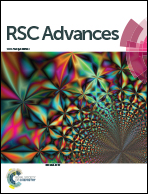Water soluble cationic porphyrin TMPipEOPP-induced G-quadruplex and double-stranded DNA photocleavage and cell phototoxicity†
Abstract
Photodynamic therapy (PDT) has attracted increasing interest as a promising and non-invasive method for cancer treatment. Double-stranded DNA (dsDNA) is one of the potential bio-targets in PDT, and a PDT drug that could photocleave telomeric G-quadruplex might efficiently kill tumor cells by shortening the telomere length. Herein, a water soluble cationic porphyrin derivative 5,10,15,20-tetra-{4-[2-(1-methyl-1-piperidinyl)ethoxy]phenyl} porphyrin (TMPipEOPP) was demonstrated to be a promising PDT agent. It shows no DNA damage ability in the dark, but efficiently cleaves both double-stranded plasmid DNA and telomeric G-quadruplex DNA under irradiation by producing reactive oxygen species 1O2. However, since TMPipEOPP has much higher binding affinity to G-quadruplex than to dsDNA, it can preferentially bind to and specifically photocleave telomeric G-quadruplex in the presence of dsDNA with identical nucleotide concentrations, thus suggesting that it might be used as a human telomere-targeted photosensitizer for PDT of tumors. Correspondingly, almost no cytotoxicity is observed for TMPipEOPP in the dark, but efficient PDT-induced apoptosis is shown towards human colon carcinoma cells (HCT-8).


 Please wait while we load your content...
Please wait while we load your content...